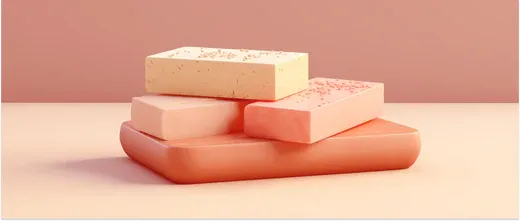
Crafting a Profitable Soap-Making Business: Your Ultimate Guide
Table of Contents
- Key Highlights:
- Introduction
- What is Soap-Making?
- The Benefits of Starting a Homemade Soap Business
- Is a Handmade Soap Business Profitable?
- Creating Your Soap Business Plan
- Sourcing Suppliers and Managing Costs
- How to Make Soap to Sell
- Handmade Soap Legal and Safety Requirements
- How to Price Your Homemade Soap for Profit
- How to Sell Your Handmade Soap
- Start a Profitable Soap-Making Business
Key Highlights:
- Artisanal Demand: Soap is an essential commodity with a rising demand for artisanal and eco-friendly options, making it a lucrative market for entrepreneurial spirit.
- Profit Potential: Artisan soap makers can achieve profit margins of 25-50%, with an average profit margin of around 40%, translating to a retail price of $6-$12 per bar compared to a production cost of $1-$3.
- Effective Strategies: Establishing a solid business plan, defining your unique selling proposition, and leveraging online platforms and social media for marketing are key steps in transforming a soap-making hobby into a thriving business.
Introduction
Soap-making is more than just a creative outlet; it’s a vibrant intersection of art and commerce that can lead to a fulfilling and profitable endeavor. With the rising trend of sustainability and natural beauty products, soap-making presents a unique opportunity for budding entrepreneurs. Whether you are an experienced crafter or a curious newcomer, this comprehensive guide will take you through the essential steps, from mastering the craft of soap-making to setting up a successful home business.
What is Soap-Making?
At its core, soap-making involves the chemical process known as saponification, where oils or fats react with an alkali, typically lye. This age-old practice transforms basic ingredients into a versatile product that can be customized with various additives, fragrances, and colors. The essential steps involved in making soap include:
- Mixing: The process starts by combining chosen oils with a lye solution, initiating the saponification reaction.
- Molding: The mixture is then poured into molds and left to set, taking its shape.
- Curing: After initial hardening, the soap must cure for several weeks to ensure the chemical reaction is complete and achieve its final texture and quality.
Understanding these fundamentals is crucial for anyone looking to embark on this profitable journey.
The Benefits of Starting a Homemade Soap Business
Launching a homemade soap business not only allows you to embrace your creative side but also provides access to a profitable and constantly in-demand market. Here are some compelling reasons to consider this venture:
High Demand
Soap is universally needed, and as consumer preferences shift towards artisanal and handmade products, the demand for unique soap varieties is on the rise. With an inclination towards sustainability, more consumers are leaning toward natural and eco-friendly alternatives.
Creativity and Branding
Soap-making is a highly creative process that allows for personalization from the choice of scents and colors to innovative packaging. This element of creativity can help shape a unique brand identity that stands out amidst a sea of mass-produced alternatives.
Eco-Friendly Appeal
Consumers today are more eco-conscious than ever, preferring handmade soaps made with natural ingredients over synthetic options. This growing preference is reflected in market trends that favor brands that prioritize sustainability.
Profitability
The financial aspect of soap-making can be attractive, as the materials required for production are generally low-cost. Furthermore, depending on the brand positioning, homemade soaps can be sold at a premium price, thereby generating substantial profit margins.
Flexibility
Soap-making can easily be operated as a home-based business, which provides the flexibility to work on your terms while maintaining a low overhead. This is particularly beneficial for those balancing personal commitments with entrepreneurial ambitions.
Community Connection
Engaging with local markets and events allows soap-makers to build connections and foster brand loyalty within their communities. This personal touch is often what sets artisanal brands apart from the competition.
Online Sales Opportunities
The nature of soaps makes them ideal for packaging and shipping, opening doors for online sales that can extend your reach beyond local consumers.
Is a Handmade Soap Business Profitable?
Yes, it can be highly profitable. Many artisans in the soap-making industry report gross profit margins ranging between 25% and 50%, with an average profit margin around 40%. The production cost of a single bar of soap often lies between $1 and $3, while the retail price can reach from $6 to $12.
With the global soap market projected to reach $66.5 billion by 2032 due to increased hygiene awareness and preference for natural products, the potential for profitability in this craft is evident.
Creating Your Soap Business Plan
Establishing a detailed business plan is paramount for any aspiring entrepreneur. Here are vital components to consider:
Identify Your Target Market and Niche
Understanding your ideal customer is essential for tailoring your products effectively. Create buyer personas that detail demographics such as age, income, and shopping habits. Key segments you might consider include:
- Eco-conscious shoppers seeking low-waste packaging.
- Clean beauty enthusiasts who prioritize natural and organic ingredients.
- Consumers looking for functional skincare products with beneficial additives.
Defining these personas allows you to address their specific pain points through your products.
Defining Your Unique Selling Proposition
To successfully market your soap, you must differentiate your products. Your unique selling proposition (USP) should be based on thorough market research. Examples of USPs include:
- Highlighting a special ingredient, such as locally sourced goat's milk.
- Creating a memorable scent profile that customers can associate with your brand.
- Demonstrating your commitment to sustainability through practices like using plastic-free packaging.
Experimenting with Scents and Colors
Sensory appeal plays a significant role in attracting customers. Experimenting with different combinations can help you identify popular products. Seasonal themes and color schemes can evoke specific emotions or memories that enhance the customer experience. Utilizing essential oil blends can also create signature scents that leave a lasting impression.
Adding Unique Ingredients
Incorporating special ingredients can attract specific customers. Consider adding:
- Natural exfoliants such as oatmeal or coffee grounds for added texture.
- Skin-beneficial components like aloe vera to cater to health-conscious buyers.
- Specialty oils for high-end, luxury soap lines.
Designing Attractive Soap Packaging
Effective packaging not only protects the product but serves as an extension of your brand. Key considerations include:
- Using eco-friendly materials that resonate with consumer values.
- Maintaining consistency in branding to enhance recognition.
- Ensuring practicality and protection of the soap during shipping and display.
Sourcing Suppliers and Managing Costs
Finding the right suppliers is essential for maintaining quality while managing costs. Look for wholesale suppliers who support small businesses and offer favorable terms. Some recommended suppliers include:
- Bulk Apothecary: Known for low minimum order quantities.
- Wholesale Supplies Plus: Offers a variety of soap-making materials from molds to ingredients.
- Bradford Soapworks: Ideal for high-end private-label manufacturing.
Evaluating suppliers thoroughly ensures that you maintain quality while scaling the business effectively.
How to Make Soap to Sell
Creating soap requires careful preparation and a focus on safety. Here’s a simplified guide to making your own soap:
Ingredients Needed
- Fats or oils (animal or plant-based)
- Lye (sodium hydroxide)
- Water
- Optional fragrances, colorants, and additives
Steps to Make Soap
- Gather Ingredients: Assemble your components and ensure they meet your quality standards.
- Prepare Workspace: A clean, ventilated space with protective equipment is crucial.
- Get the Soap Base Ready: Depending on your method, either melt a base or mix lye into water.
- Combine Base with Additives: Mix thoroughly to ensure even distribution.
- Pour into Molds: Carefully transfer the mixture into molds and tap out any air bubbles.
- Cure the Soap: Allow the soap to rest in a dry area for 4-6 weeks to cure fully.
- Unmold and Cut: Once set, remove the soap from molds and cut into bars.
- Package and Label: Protect your soap with packaging that includes all essential labeling information.
Handmade Soap Legal and Safety Requirements
Understanding the regulatory landscape is vital to ensuring compliance in your soap-making venture. In the U.S., several key regulations apply:
FDA Regulations and MoCRA
Under the Modernization of Cosmetics Regulation Act (MoCRA), all cosmetic facilities must register their products with the FDA, including homemade soap operations. The law mandates accurate labeling and disclosure of all ingredients.
Product Liability Insurance
To safeguard your business, obtaining product liability insurance is advisable. This helps protect your venture against potential claims arising from allergies or adverse reactions.
Good Manufacturing Practices (GMP)
Following established GMP guidelines can help maintain quality and compliance. Some best practices include:
- Maintaining cleanliness in your workspace.
- Keeping precise ingredient records for batch identification.
- Storing materials appropriately to prevent contamination.
How to Price Your Homemade Soap for Profit
Effective pricing strategies are crucial for profitability. Here’s how to approach pricing your soap:
Calculate Your Cost of Goods Sold (COGS)
Add all direct costs involved in producing your soap, including materials and labor. This total can inform your pricing strategy.
Research Competitors and Perceived Value
Analyzing competitors can provide insight into price ranges and customer expectations. The perceived value of premium ingredients can allow you to set higher prices.
Simple Pricing Formula
A straightforward pricing approach might include:
- For retail (direct-to-consumer): COGS × 4.
- For wholesale: COGS × 2.5, allowing for retailer markup while maintaining profit.
Reassessing your pricing strategy regularly ensures that you remain competitive and adjust to market changes.
How to Sell Your Handmade Soap
Maximizing visibility is key to sales success. Here’s a multi-faceted approach:
Create an Online Store
Building an online presence allows you to reach a broader audience. Ensure your site is user-friendly, visually appealing, and equipped with high-quality product images to attract customers.
Promote Your Soap on Social Media
Utilize platforms like Instagram, Facebook, and TikTok for marketing. Regular engagement through storytelling, customer interactions, and behind-the-scenes views can keep your audience informed and engaged.
Integrate Omnichannel Selling Strategies
Consider selling at local markets, fairs, and through retail shops. Using systems like Shopify POS can streamline selling both online and offline while keeping your inventory in sync.
Engage with Customers
Tailor interactions based on customer data. Develop loyalty programs to nurture repeat business and encourage customer engagement through personalized recommendations and localized promotions.
Sell on Marketplaces
Expanding your reach through online marketplaces like Etsy and Amazon can facilitate sales growth. Integrating your Shopify account with these platforms aids in inventory management and order fulfillment.
Start a Profitable Soap-Making Business
With the insights shared in this article, you can turn your passion for soap-making into a viable business model. Focus on understanding the craft, identifying your market, and effectively promoting your products to achieve success.
FAQ
How do you make soap at home?
To make soap at home, mix lye with water (always adding lye to water), melt and combine your chosen oils, stir the mixture until it thickens, add any fragrances or additives, pour into molds, and allow it to cure for several weeks.
Can I make soap and sell it online?
Absolutely! You can sell your homemade soap online. Ensure you follow all legal guidelines, create an appealing online store, and develop a marketing strategy to attract customers.
Is selling homemade soap profitable?
Yes, with the right pricing and marketing strategy, selling homemade soap can be quite profitable.
Do you need a license to sell soap?
While you don’t need a specific soap-selling license in the U.S., you may require a business license and must adhere to FDA guidelines.
How much does it cost to start making your own soap?
Starting a soap-making business can cost between $500 and several thousand dollars, depending on the scale and quality of materials used.
Do I need FDA approval to sell soap?
No, you don’t need FDA approval if your soap is strictly marketed as a cleansing product and meets the regulatory definition of soap.
How much do homemade soaps sell for?
Homemade soaps typically range from $3 to $12 per bar based on quality, ingredients, and market demand. Prices may vary significantly based on perceived value and specialty offerings.
POWER your ecommerce with our weekly insights and updates!
Stay aligned on what's happening in the commerce world
Email Address
Handpicked for You

22 August 2025 / Blog
Navigating Customer Experience Trends: Strategies for 2024 and Beyond
Read more
22 August 2025 / Blog
Maximizing Efficiency: A Comprehensive Guide to Customer Service Outsourcing
Read more
22 August 2025 / Blog


